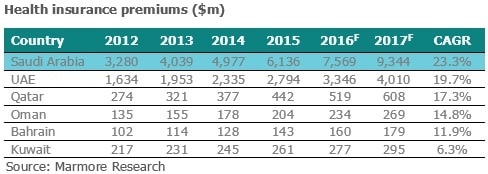الرعاية الصحية في المملكة العربية السعودية: أين الفرص؟
The government is benevolent to the extent that it pays for all medical charges even outside the country if it is deemed necessary for a patient to travel abroad for advanced healthcare facilities.
Saudi’s healthcare system is comprised of three service providers – the Ministry of Health (MoH) hospitals, government hospitals and private hospitals. However, gaps are evident in the services offered to the people.
The kingdom is projected to require 15,888 beds in 2018, accounting for almost 50 per cent of total requirements in the Gulf Cooperation Council. The health ministry has commissioned few projects to bridge the gap in healthcare infrastructure, so given the increase in demand it is vital that private players’ participation is encouraged – otherwise health infrastructure might lag behind.
In terms of financial stimulus, the government can choose from multiple options to offer incentives to private players. Public private partnership projects are expected to be the show-starter for improving private participation in various sectors in the kingdom.
One such PPP project is the Saudi Trans Sadara Company and China International Development and Investment Corporation Limited (CIDIC) joint venture to build four private hospitals in Dammam, Jubail, Riyadh, and Jizan, with a total project cost of $350m. These hospitals are expected to be fully operational by the end of 2017 and are expected to generate more than 2,000 jobs for young Saudi nationals in the fields of nursing, procurement, marketing, administrative affairs, pharmacy and safety and security.
Another segment in healthcare where there is immense opportunity is drug manufacturing. There are approximately 200 pharmaceutical companies (mainly retailers) in Saudi Arabia, registered with the Ministry of Health. European suppliers largely dominate the market.
Due to low domestic pharmaceutical production in Saudi Arabia, approximately 85 per cent of the drugs that are sold are imported. This opens the gates for generic drug manufacturers in the country – especially when you consider the cost aspect. At present more than 70 per cent of all prescription drugs sold in Saudi Arabia are patented, which are usually more expensive than generics owing to the R&D and compliance costs involved.
A growing population and increasing instances of lifestyle related diseases opens up a huge market for generic drug makers, with patients’ cost-consciousness likely to be driven by an expected decline in government support for healthcare in the coming years.
Local players hold a market share of around 25 per cent and predominately manufacture generic drugs. It is expected that the domestic drug manufacturers will have the opportunity to capture higher market share in the coming years, provided regulation is amended to be favourable for fostering generic drugs.
The Saudi Arabian medical device production sector remains in its nascent stages and imports account for 92 per cent of market supplies – 21 per cent of which from the United States. The total expenditure on medical equipment is expected to steadily increase and reach $3m by 2020 at a compound annual growth rate of 6 per cent. In general, medical equipment manufacturing is capital intensive and requires technology and skill transfer from established players in the field.
Joint ventures and public private partnerships with countries that have advanced technology and expertise in equipment manufacturing would be a viable option for Saudi Arabia to start with.
Recent developments in information and communication technology (ICT) have changed business models in all industries including healthcare. Saudi Arabia, with its well-established ICT infrastructure, offers an excellent meeting place for IT solutions to enhance healthcare services offered. Saudi’s e-Health policy aims to implement a programme in order to achieve its vision of a ‘safe, efficient health system, based on the care centred on a patient, standard-oriented, and supported by the e-Health’. These strategies were launched in 2011 in two phases, each one extending for five years.
There is a long way to go in order to make the country’s healthcare facilities IT enabled in terms of patient management systems, hospital information systems, quality controls for suppliers and service providers and integrated pharmaceuticals and insurance claims. Private participation can be channelled into the area of providing healthcare firms with IT-enabled services in the country to improve the efficiency and effectiveness of health operations.
Health insurance penetration also remains low at 0.8 per cent of the GDP in 2015, indicating ample scope for the growth of health insurance in the country. Saudi Arabia mandates compulsory health insurance for expatriates and visitors. On the other hand various awareness creation measures have been initiated to encourage nationals to insure life and health. Medical support from the government can also be expected to decline in the coming years, so we estimate the health insurance premiums in Saudi Arabia will continue growing.

Saudi Arabia’s Takaful insurance market is expected to be vibrant in the coming years. Given the fact that Saudi Arabia restricts commercial insurance, the demand for Takaful products is set to rise. Favourable demographics, availability of Takaful insurance companies and increased income levels are all set to drive the country’s Takaful insurance sector.
According to Marmore’s report on Saudi healthcare, the kingdom’s market share of the GCC healthcare sector is the highest in the region at 54.4 per cent – equivalent to $26bn. With future demand almost certain to grow, private sector participation is set to increase. In some areas such as medical equipment manufacturing, international players might collaborate with local players to increase their domestic production.
The current situation presents a need as well as an opportunity for the development of private healthcare in Saudi Arabia but ensuring smooth transition and functioning lies with the policy makers.
